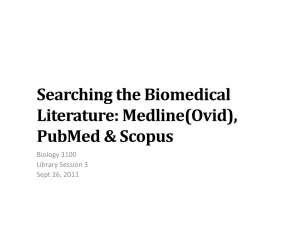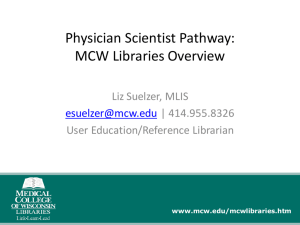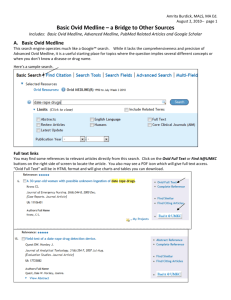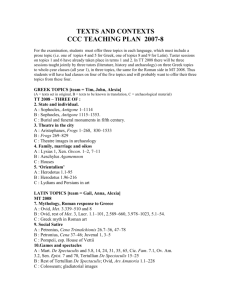Resource corner
advertisement
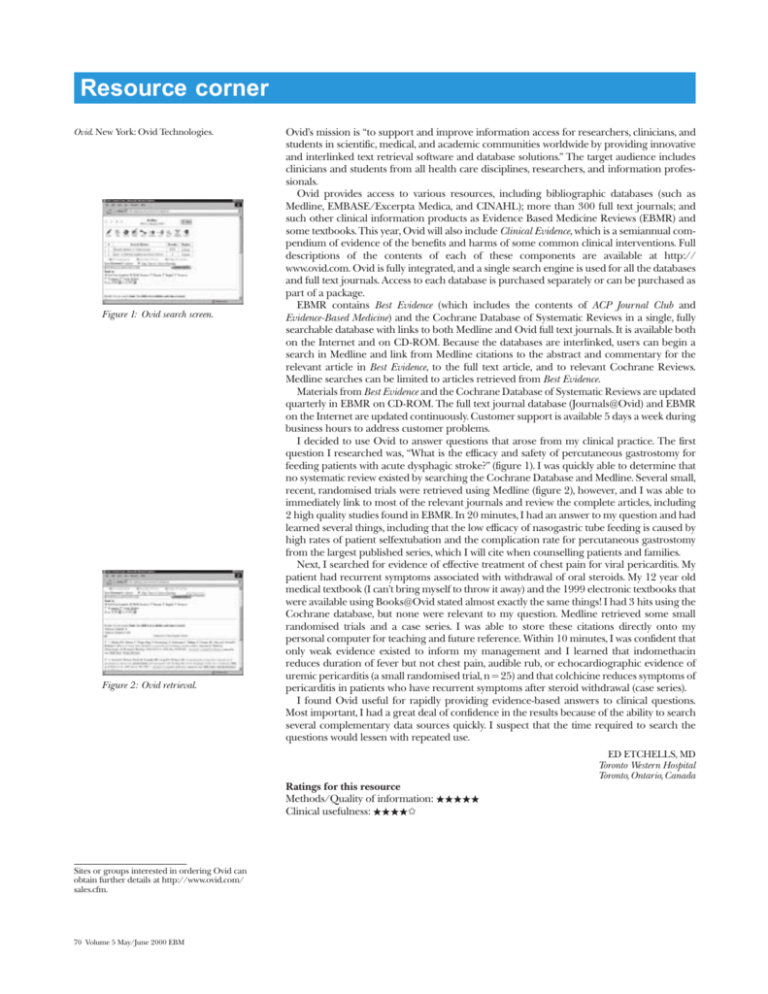
Resource corner Ovid. New York: Ovid Technologies. Figure 1: Ovid search screen. Figure 2: Ovid retrieval. Ovid’s mission is “to support and improve information access for researchers, clinicians, and students in scientific, medical, and academic communities worldwide by providing innovative and interlinked text retrieval software and database solutions.” The target audience includes clinicians and students from all health care disciplines, researchers, and information professionals. Ovid provides access to various resources, including bibliographic databases (such as Medline, EMBASE/Excerpta Medica, and CINAHL); more than 300 full text journals; and such other clinical information products as Evidence Based Medicine Reviews (EBMR) and some textbooks. This year, Ovid will also include Clinical Evidence, which is a semiannual compendium of evidence of the benefits and harms of some common clinical interventions. Full descriptions of the contents of each of these components are available at http:// www.ovid.com. Ovid is fully integrated, and a single search engine is used for all the databases and full text journals. Access to each database is purchased separately or can be purchased as part of a package. EBMR contains Best Evidence (which includes the contents of ACP Journal Club and Evidence-Based Medicine) and the Cochrane Database of Systematic Reviews in a single, fully searchable database with links to both Medline and Ovid full text journals. It is available both on the Internet and on CD-ROM. Because the databases are interlinked, users can begin a search in Medline and link from Medline citations to the abstract and commentary for the relevant article in Best Evidence, to the full text article, and to relevant Cochrane Reviews. Medline searches can be limited to articles retrieved from Best Evidence. Materials from Best Evidence and the Cochrane Database of Systematic Reviews are updated quarterly in EBMR on CD-ROM. The full text journal database (Journals@Ovid) and EBMR on the Internet are updated continuously. Customer support is available 5 days a week during business hours to address customer problems. I decided to use Ovid to answer questions that arose from my clinical practice. The first question I researched was, “What is the efficacy and safety of percutaneous gastrostomy for feeding patients with acute dysphagic stroke?” (figure 1). I was quickly able to determine that no systematic review existed by searching the Cochrane Database and Medline. Several small, recent, randomised trials were retrieved using Medline (figure 2), however, and I was able to immediately link to most of the relevant journals and review the complete articles, including 2 high quality studies found in EBMR. In 20 minutes, I had an answer to my question and had learned several things, including that the low efficacy of nasogastric tube feeding is caused by high rates of patient selfextubation and the complication rate for percutaneous gastrostomy from the largest published series, which I will cite when counselling patients and families. Next, I searched for evidence of effective treatment of chest pain for viral pericarditis. My patient had recurrent symptoms associated with withdrawal of oral steroids. My 12 year old medical textbook (I can’t bring myself to throw it away) and the 1999 electronic textbooks that were available using Books@Ovid stated almost exactly the same things! I had 3 hits using the Cochrane database, but none were relevant to my question. Medline retrieved some small randomised trials and a case series. I was able to store these citations directly onto my personal computer for teaching and future reference. Within 10 minutes, I was confident that only weak evidence existed to inform my management and I learned that indomethacin reduces duration of fever but not chest pain, audible rub, or echocardiographic evidence of uremic pericarditis (a small randomised trial, n = 25) and that colchicine reduces symptoms of pericarditis in patients who have recurrent symptoms after steroid withdrawal (case series). I found Ovid useful for rapidly providing evidence-based answers to clinical questions. Most important, I had a great deal of confidence in the results because of the ability to search several complementary data sources quickly. I suspect that the time required to search the questions would lessen with repeated use. Ratings for this resource Methods/Quality of information: ..... Clinical usefulness: ....✩ Sites or groups interested in ordering Ovid can obtain further details at http://www.ovid.com/ sales.cfm. 70 Volume 5 May/June 2000 EBM ED ETCHELLS, MD Toronto Western Hospital Toronto, Ontario, Canada SUMSearch and PubMed: 2 Internet-based evidence-based medicine tools Figure 1: SUMSearch. Figure 2: PubMed. This resource review evaluates SUMSearch (formerly SmartSearch) (figure 1), which was developed by Robert Badgett and internal medicine colleagues at the University of Texas Health Sciences Center at San Antonio, and the US National Library of Medicine’s PubMed Medline interface. In evaluating these tools we considered the following clinical scenario: A middle aged, otherwise healthy businessman presents with flu symptoms. Having listened to the debate around the new antiviral drugs for influenza you conduct a “quick and clean” search for the treatment of influenza with zanamivir. PubMed (figure 2) is a free Internet interface to the Medline biomedical database for clinicians from all health care disciplines and allows them to search using basic or advanced techniques, or clinical queries. SUMSearch allows “metasearching” (searching multiple sources) and augments PubMed access with such sources as the Database of Abstracts of Reviews of Effectiveness (DARE), the Merck Manual, and the US National Guidelines Clearinghouse. It also can invoke search filters for citations about therapy and diagnosis for example. PubMed allows field specific searching (eg, publication type), use of Boolean operators (“AND,” “OR”), review of the search strategy, iterative refinement of the number of hits, and access to a hierarchical MeSH browser (currently under development). It also provides linkages to “Related Articles” that can be very useful. In “Clinical Queries” mode, searchers can choose to maximise sensitivity (for greatest number of hits) or specificity (for most focused set of hits) for searches on therapy, diagnosis, prognosis, or aetiology. The filters used for these focused searches can be reviewed. In addition to Medline, PubMed also includes PreMedline (citations not fully indexed), providing fast track access to core journal records in advance of a full Medline entry. These lack full MeSH terminology so they require free text searching. The strength of SUMSearch is its resources but the searcher cannot see the search unfold. Further, the value of using Medline filters for searching full text sources is unproven. For this reason, the discriminatory power of the different filters used on this site seems poor. Additionally, its MeSH browser is of limited use for non-indexed terms such as zanamivir. A useful feature is its ability to present results in an abbreviated display according to publication type and source. Neither PubMed nor SUMSearch provides critical appraisal of the evidence retrieved. Both databases were searched using “influenza AND zanamivir,” and we noted the number of clinical trials and systematic reviews amongst the total retrieved items. References were then reviewed for clinical usefulness. Both databases retrieved clinically useful articles for issues of therapy but with SUMSearch we found a larger number of relevant diagnosis articles. The clinical usefulness of these databases is limited by the fact that, in most cases, only abstracts are provided and often a full text article is needed to answer clinical questions. Both PubMed and SUMSearch are applicable to a “quick search” scenario. Their trade off is sophistication of features versus breadth of coverage. We think that SUMSearch is probably more useful for retrieving information from reviews and guidelines, and PubMed is more useful for obtaining information from original studies. Ratings for this resource Methods PubMed ....✩ SUMSearch ...✩✩ ANDREW BOOTH, MSc, Dip Lib ALAN O’ROURKE, MB ChB, MSc School of Health and Related Research University of Sheffield Sheffield, England, UK Clinical usefulness ...✩✩ ...✩✩ SUMSearch is available at http://sumsearch.uthscsa.edu/searchform45.htm. PubMed is available at http://www.ncbi.nlm.nih.gov/entrez/query.fcgi. EBM Volume 5 May/June 2000 71
